ALP 8.9%
Incumbent MP
Justine Elliot, since 2004.
Geography
Far north coast of NSW. Richmond covers Tweed Heads, Byron Bay, Murwillumbah, Mullumbimby and surrounding areas. It covers the entirety of Tweed and Byron council areas, as well as northern parts of Lismore and Ballina council areas, although it does not cover the towns of Lismore or Ballina.
Redistribution
The recent NSW redistribution saw no changes to the boundaries of Richmond.
History
Richmond is an original federation seat, and has always covered the northeastern corner of New South Wales, although it has contracted further into that corner over the last century as other seats have been created in northeastern NSW. The seat was consistently held by conservative parties from its creation until 1990, and was gained by the Country Party early in its existence in 1922, and they held it continously for almost seventy years. Recently it has become a much more marginal seat, although the 2007 election result pushed the seat out of the marginal category.
The seat was first won in 1901 by Protectionist Thomas Ewing, who served as a minister in the Deakin government from 1905 to 1908 before retiring in 1910. His seat was retained by Liberal candidate Walter Massy-Greene. Massy-Greene went on to serve as a minister in Billy Hughes’ Nationalist governments, but lost Richmond to Country Party candidate Roland Green in 1922. He was appointed to the Senate in 1923, and served there until his retirement in 1938. He was relegated to the backbench during the Stanley Bruce government, but returned to the ministry as part of the Lyons government in the 1930s.
Green was regularly challenged by other Country Party candidates at subsequent federal elections. While the ALP stood in Richmond in 1925, Green was reelected unopposed in 1928 and faced opposition only from another Country Party candidate in 1929. At the 1931 election Green was challenged by three other Country candidates and one independent. He was regularly challenged by Robert Gibson at every election from 1928 to 1937. Green barely held on against internal party opponents at the 1931 and 1934 elections.
In 1937, two Country Party candidates and an ALP candidate all stood against the sitting Country MP. While Green came first on primary votes, Gibson’s preferences pushed Country candidate Larry Anthony ahead of the ALP candidate, and then ALP preferences gave the seat to Anthony.
Anthony served as a minister under Robert Menzies and Arthur Fadden in 1940 and 1941 and was a senior member of the Opposition during the Curtin/Chifley Labor government. In 1949 he joined Robert Menzies’ cabinet, and served in it until his death in 1957.
The subsequent by-election saw four Country Party candidates stand, although one clearly stood out, with Anthony’s son Doug polling 49.8% of the primary vote.
The younger Anthony joined the ministry in 1964 and was groomed to be the next leader of the Country Party, and upon Jack McEwen’s retirement in 1971 he became Deputy Prime Minister. The Coalition lost power in 1972, and Anthony returned to the role of Deputy Prime Minister upon the dismissal of the Whitlam government in 1975. He served in this role throughout the Fraser government, during which time his party’s name changed first to the National Country Party and then to the National Party. Following the election of the Hawke government in 1983, Anthony retired in 1984.
The seat was retained in 1984 by Nationals state director Charles Blunt, outpolling a Liberal Party challenger and overtaking the ALP on Liberal preferences, despite Blunt having no local links with the far north of NSW. Blunt immediately moved to the shadow ministry and in 1989 managed to win a leadership challenge against Ian Sinclair. His leadership saw attempts to modernise the party and bring it closer to the Liberal Party, but Blunt’s leadership was cut short in 1990 when he lost Richmond to ALP candidate Neville Newell, who won a slim margin after a 7.1% swing. While the Nationals margin had fallen below 60% in the 1980s, this still saw a big jump in the ALP vote.
Newell held on in 1993 against a challenge from Nationals candidate Larry Anthony (son of Doug and grandson of Larry Sr) and a Liberal candidate. In 1996, Newell was defeated by the third-generation of the Anthony family. Newell went on to hold the state seat of Tweed from 1999 until his defeat in 2007.
Anthony was reelected in 1998 and 2001, although won by slim margins very different to the huge margins won by his father and grandfather. The 2004 election saw Anthony, then a junior minister in the Howard government, defeated by ALP candidate Justine Elliot, against a national swing to the Coalition in a backlash against Mark Latham’s leadership of the ALP.
Elliot gained a 7.4% swing in 2007, increasing her margin to 58.9%, and she was appointed Minister for Ageing in the first Rudd ministry.
Candidates
- Joan van Lieshout (Liberal) – Tweed councillor.
- Justine Elliot (Labor) – Member for Richmond since 2004 and Minister for Ageing.
- Matthew Hartley (Independent)
- David Robinson (Democrats)
- Nic Faulkner (Independent)
- Alan Hunter (Nationals)
- Julie Boyd (Independent)
- Joe Ebono (Greens)
- Stephen Hegedus (Independent)
Political situation
While the ALP’s margin appears solid, the large swing in 2007 may not be totally solid. This area has also been shifting away from the National Party in a way which may make the Liberal Party a stronger opponent to the ALP. This election may see the ALP manage to hold on without too much trouble, but could be interesting if the Liberal Party can overtake the Nationals and become the main conservative party in this area. Richmond has some very strong areas for the Greens around Byron and Lismore, however lower results in the Tweed area brings down the overall Greens votes. This is one of the best Greens seats in regional Australia.
2007 result
| Candidate | Party | Votes | % | Swing |
| Justine Elliot | ALP | 35,699 | 43.81 | +8.15 |
| Sue Page | NAT | 30,134 | 36.98 | -7.53 |
| Giovanni Ebono | GRN | 12,168 | 14.93 | +1.32 |
| Daniel Farmilo | LDP | 1,320 | 1.62 | +1.62 |
| Barbara Raymond | CDP | 1,039 | 1.28 | +1.28 |
| Scott Sledge | DEM | 950 | 1.17 | +0.12 |
| Graham McCallum | CEC | 176 | 0.22 | +0.16 |
2007 two-candidate-preferred result
| Candidate | Party | Votes | % | Swing |
| Justine Elliot | ALP | 47,973 | 58.87 | +7.43 |
| Sue Page | NAT | 33,513 | 41.13 | -7.43 |
Booth breakdown
Richmond is covered by four local government areas. A majority of voters live in Tweed LGA, so booths in Tweed have been divided between those in Tweed Heads and along the coast, and those in the Tweed Valley. The ALP won a majority in all areas, alhough there was substantial variation. The ALP won over 70% in Byron and 66% in Lismore, winning majorities under 60% in the other areas. The Nationals performed most strongly in the four Ballina booths, polling 47.5% of the two-party preferred vote.
The Greens vote varies dramatically. The Greens polled over 30% in Byron and almost 30% in those parts of Lismore in the seat of Richmond. They polled just under 15% in Ballina and in inland parts of Tweed LGA. In the Tweed Heads and nearby coastal areas, which are by far the most populous part of the seat, the Greens polled less than 7%, massively dragging down their seatwide result.
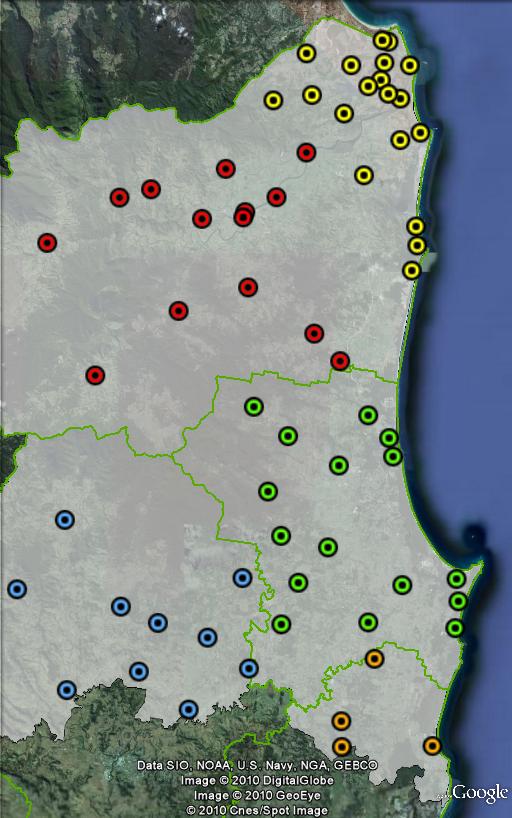
| Voter group | GRN % | ALP 2CP % | Total votes | % of votes |
| Tweed Heads & Coast | 6.88 | 54.91 | 29,716 | 36.47 |
| Byron | 30.95 | 70.15 | 14,522 | 17.82 |
| Tweed Valley | 14.61 | 59.46 | 9,558 | 11.73 |
| Ballina | 14.92 | 52.48 | 4,678 | 5.74 |
| Lismore | 29.85 | 66.21 | 4,436 | 5.44 |
| Other votes | 11.91 | 55.95 | 18,576 | 22.80 |
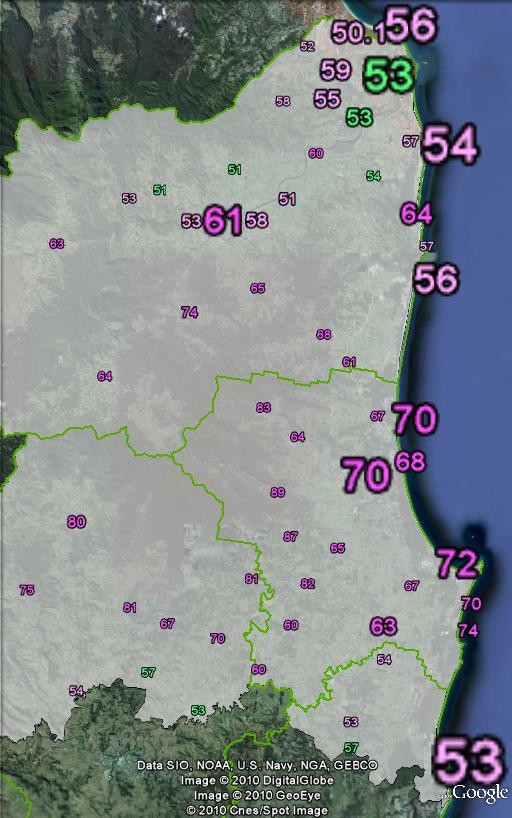
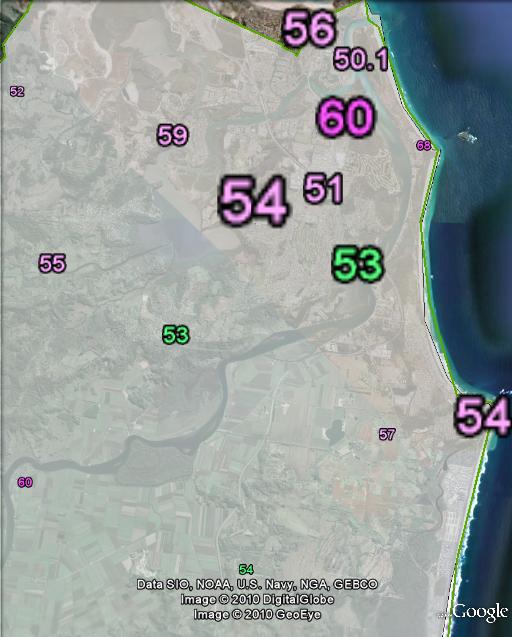
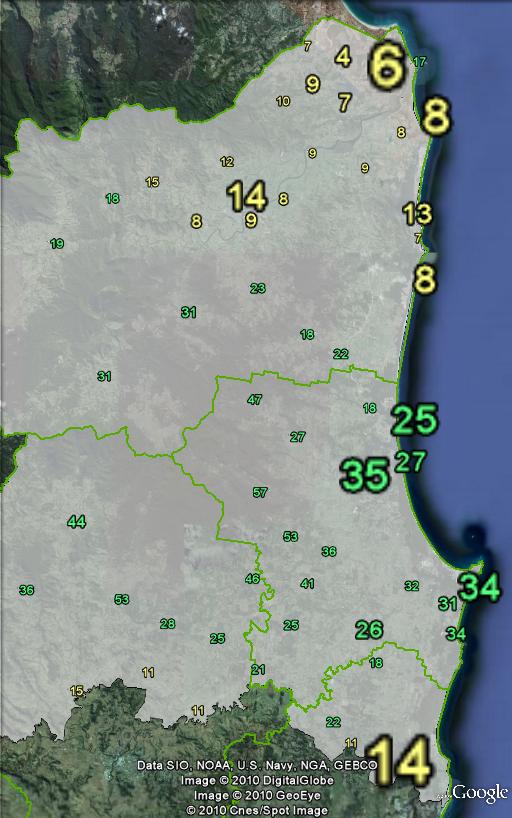
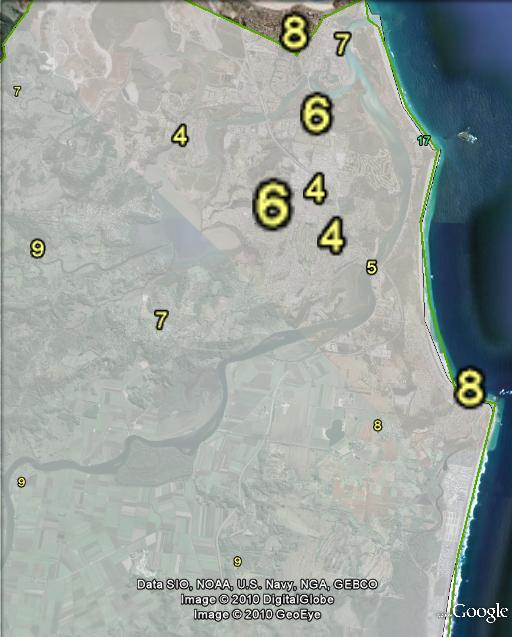


Regular commenter Nick C helped me out by putting together these maps.
Ben, there appears to be a typo about halfway down the History section.
I do love the Hinterland area up there. I think the Greens best booth results were in Richmond in ’07.
Hard to see Elliott losing this time around, though I would argue that the real battle is for the conservative heart and soul of the Tweed. If the Libs beat the Nats it could start a bit of a chain reaction, or at the least set a precedent for the North Coast (both Federal and State).
I had no idea there was a rural electorate where the Greens actually went well. Might be a nice place to retire.
Hans, this if often regarded as the birthplace of the environment movement in Australia. It was the site of the first anti-logging protests in the 1970s, and Bob Brown and others often acknowledge how valuable the contribution of experienced activists from the north coast was to the Franklin campaign.
Regarding the 1990 results, there wasn’t a jump in the ALP primary vote, only in 2PP terms (the ALP primary vote jumped subsequently in 1993). The ALP primary vote was down 8.5% – the 1990 result was all courtesy of the impact of Helen Caldicott, who only narrowly missed out on getting ahead of Labor, and her preferences then flowed strongly to Newell. The result was one of the biggest stories of the 1990 election – the ALP win coming as a shock to everyone, not least Newell, whom the story goes wasn’t exactly expecting to become an MP.
Actually the other point I could make about Richmond is that the name really confuses people. Since the Richmond River is no longer in the electorate, the geographic name doesn’t make much sense any more. I did make a submission to the 2006 redistribution suggesting it be renamed, but being an original division, that ain’t gonna happen.
They could always swap the name with Page. The confusion that would cause would be worth watching.
Another wonderful seat analysis Ben. 🙂 Just a quick squiz at the 2007 results – shouldn’t it be a +7.43% TO THE ALP in the 2CP – otherwise doesn’t quite make sense.
Thanks Hamish, fixed it.
Serial candidate, or serial prospective candidate at least, Nic Faulkner of Brunswick Heads, has unsurprisingly announced his intention to run for Richmond. I believe he’s made similar announcements before the last two federal elections, whilst questioning the legitimacy of those elections, but hasn’t actually made it onto a ballot paper since the 2003 state election, I think.
Faulkner joins Matthew Hartley, apparently a disgruntled former ALP member from the Byron Bay area, who also announced his candidacy a month or so ago. The Greens candidate has been decided, but will not be formally confirmed until later this month.
Interesting fact about the Greens vote in Richmond: 6 out of the top 10 booths in percentage terms for the Greens in the House of Reps in 2007 were there, as well as 4 of the top 10 booths on the Senate votes. Unfortunately they are all small booths under 1,000 votes.
Incidentally 8 out of those top 10 booths on House of Reps votes were in NSW, the others being Elands in Lyne, and the booth on Dangar Island in Berowra. The two non-NSW booths were the booth at Fern Tree, west of Hobart (Denison), which came in at No. 5, and the booth at Wreck Bay in the Jervis Bay Territory (Fraser), which placed 8th. In terms of booths with over 1,000 formal votes cast, the top 3 were all in NSW. The first being Bellingen (Cowper), followed by Newtown North (Sydney) and Mullumbimby (Richmond). On the Senate votes a swag of booths in Denison jump up the rankings, owing to the Senate vote being much greater than the House of Reps vote down there – that Fern Tree booth had a 62% Senate vote. Mount Nebo, north-west of Brisbane (Dickson), also makes it into the top 10 on the Senate votes.
A shock development this morning, with Tania Murdock quitting as Nationals candidate.
http://www.northernstar.com.au/story/2010/06/01/nationals-preselect-new-candidate/
“People interested in standing should contact the Richmond Nationals Vice Chairman Alan Martin on 0400 402 106, (07) 5524 6938 or email: alanmartin1117@hotmail.com“
Anyone on here fancy a run for the nats?! Sounds a little desperate
We can now confirm that Giovanni Ebono will again be the Greens candidate, it is mentioned here.
Ben, when you updated the candidates section you neglected to remove Tania Murdock. You have also yet to add the two independents.
At least two candidates have nominated for take two of the Nationals preselection, one of them being Murwillumbah businessman Phil Taylor.
There are a total of four nominations for the Nationals’ preselection. The other three are Alan Hunter of Myocum (near Mullumbimby), Tweed Heads pharmacist Brian Curran, and Lismore solicitor Jim Fuggle, who lives in Alstonville, which the Daily Snooze claims here is ‘just inside the Richmond boundary’. Well, Alstonville hasn’t been in Richmond since before the 2006 redistribution, so they’ve got a bit of catching-up to do.
I’m not sure the Nats should really bother at this point. The Liberals have a candidate who should do well against Elliot amongst the key voters in the Tweed, they’d probably be smarter just to get behind her.
Thanks for that Nick. While their campaign has been a dogs breakfast and there is no doubt they cannot win, I think the fact it used to be “the jewel in the crown” means there is atleast pride at stake. Also a good result here for the Libs could give them future cracks at tweed at a state level should Provest lose. They have to atleast put up a fight against further LP advances into their territory. What will be interesting is that the Nats really cannot afford to even come 3rd, but common sense tells you one of the conservative parties should finish 4th.
Hmm, I didn’t think of that, that the Greens could beat one of the Tory parties, though you’re right Peter, in Richmond it’s quite possible, especially if the Greens can add a few percent to their tally. One would have to think that van Lieshout would be the favourite (v the Nats) given Tweed demographics and the mess surrounding Nat preselection. That’s a hilarious photo on the Tweed News link.
Alan Hunter is the new Nationals candidate.
Well we don’t know exactly when Julia is going to see the G-G, but Nic Faulkner wants an audience with her, and if he has his way, there’ll be no election for a while.
Another independent has entered the running here. Sources tell me that Julie Boyd, a community activist from Hastings Point who contested Tweed at the last state election, has nominated this morning.
[website under development]
I am running as an Independent candidate for the seat of Richmond. I am a Byron Bay based lawyer. I worked for the last four years as a native title lawyer in Western Australia. I studied at Southern Cross University, graduating in 2003 with an Honours degree in Law and a Bachelor of Indigenous Studies. I was elected Chair of the Student Representative Council in 2000. I am passionate about human rights, the environment and community advocacy. I am a keen surfer. I grew up in Brisbane, and first moved to Byron in 1994, after studying philosophy for a year at the University of Queensland.
Great! The more genuine local independent candidates there are, the more representative our elections. Good luck, Stephen.
Great. Thanks for the positive feedback.
Related to Andras Hegedus the former Stalinist Hungarian PM turned dissident?
http://www.northernstar.com.au/story/2010/08/14/Greens-have-out-polled-Nationals-poll-shows/
Not sure that our local APN papers have had a very good track record with polls, and the analysis of this one is fundamentally flawed, but it does suggest the Liberals will clearly overtake the Nats as the main conservative party, and I think that’s a fair assumption.
I heard that the Greens candidate was assaulted at Tweed today.
Animals.
Hamish Coffee Says:
heard that the Greens candidate was assaulted at Tweed today
They seem to make of habit of that dont they ?
Dont try to blame us for that one. I dont have a team in the Tweed
Yep. He chose to go confront the ‘enemy’ head-on:
http://www.nbntv.com.au/index.php/2010/08/14/protesting-fishermen-lash-out-at-greens/
Greens are copping a lot of flak and misinformation in seats up and down the coast regarding marine parks. Coalition have been out whipping up fear and hysteria, even more so down in Cowper.
My prediction: Labor retain. It’s a healthy margin, but expect a surprisingly large anti-Labor swing – 5% +. Libs to be the challenger.
Not much swing here, but Elliot did suffer a drop in her primary vote that’s obviously come back to her via preferences from the Greens and left-wing independents. There was a reasonable increase in the Greens Senate vote here too. Liberals didn’t quite make it to overtake the Nats.
Matt Hartley, joined the ALP because I thought they needed all the help they could get to remove Howard. Having been in there, I could see why: the party is basically hostile to thought and ideas, hence pre-selects and promotes people without any.
I’ll be staying involved.
One thing I could add here, which I’ve since learned, is that the Labor campaign in this seat was evidently boosted significantly by the spill-over from Janelle Saffin’s highly-effective campaign in Page. Saffin’s high visibility apparently generated a degree of confusion which led some to believe she was the local MP for this area. Curious effect, but makes perfect sense.
So despite all the hype, the Liberals could not outpoll the Nationals even though the Nats had to replace their candidate at the last minute with a retired farmer. I wonder what the millionaire housewife van Lieshout has to say about that.
Her campaign really seemed to flounder – she was practically invisible in the southern end of the seat.
And well, now she’s reportedly considering contesting the state seat of Tweed as an independent:
http://www.tweednews.com.au/story/2010/11/08/council-lieshout-tweed/